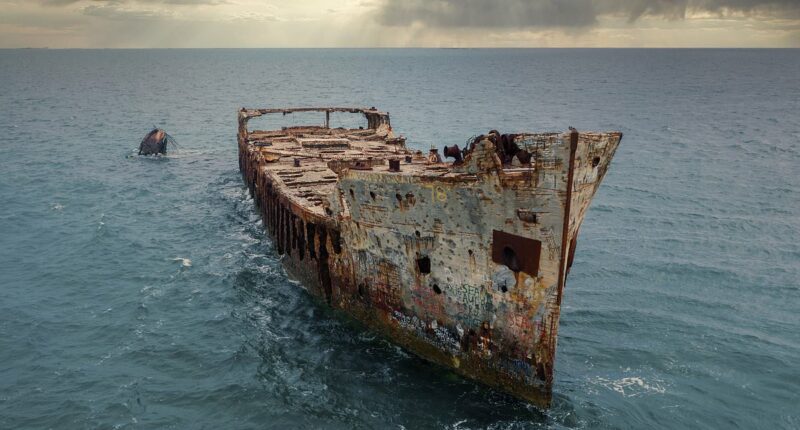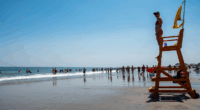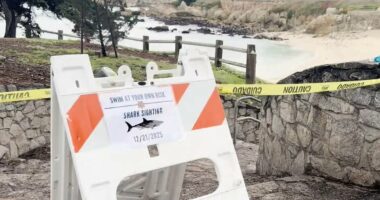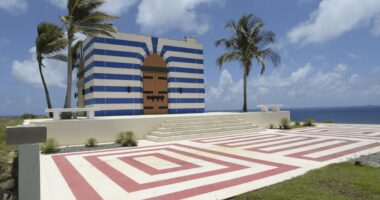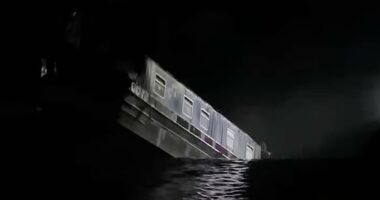Share this @internewscast.com
From vanishing aircraft to sinister ghost ships, the Bermuda Triangle is the location of some of the planet’s strangest phenomena.
Now, a scientist claims to have finally solved the mystery.
Located between Florida, Puerto Rico and Bermuda, the Bermuda Triangle’s long history of deadly wrecks has prompted endless supernatural speculation.
Dr. Simon Boxall, an oceanographer at the University of Southampton, clarifies that the true explanation for phenomena in the Bermuda Triangle does not involve UFOs or mysterious portals between dimensions.
Instead, Dr Boxall says that the Bermuda Triangle’s record of disappearances is due to ‘rogue waves’.
Otherwise known as extreme storm waves, these are unpredictable walls of water that can reach twice the height of the surrounding waves.
Rogue waves, which can reach heights of up to 100 feet (30 meters), are unusually steep and can strike unexpectedly from directions that differ from the dominant wind.
According to Dr Boxall, a large ship trapped by one of these killer swells could ‘sink in a matter of two or three minutes’.

The Bermuda Triangle is infamous for its shipwrecks, including the well-known SS Sapona. Yet, a scientist now proposes a solution to the mysteries of this perilous area.
Theories surrounding the deadly pull of the Bermuda Triangle have spread widely ever since the disappearance of the USS Cyclops in 1918.
The USS Cyclops was an American coal-carrying ship that had been used to ferry fuel to warships during World War I.
Back in March 1918, the ship USS Cyclops was traveling through the Bermuda Triangle from Salvador, Brazil, to Baltimore when it disappeared without a trace, not even sending a distress signal.
Despite an extensive search, no trace of the 542-foot (165-metre) vessel or its 306 crew members has ever been found.
The sudden vanishing of the USS Cyclops has led to numerous outlandish theories by conspiracy theorists and UFO believers attempting to rationalize its loss.
However, Dr Boxall says that the USS Cyclops was more likely to have been sunk by a rogue wave.
In the Channel 5 documentary series, The Bermuda Triangle Enigma, Dr. Boxall notes that the Bermuda Triangle is particularly prone to rogue wave activity.
He says: ‘There are storms to the south and north, which come together.

Dr Simon Boxall, an oceanographer from the University of Southampton, says that disappearances of ships like the USS Cyclops (pictured) could be due to ‘rogue waves’

Rogue waves up to 100 feet (30 metres) in height are triggered by the convergence of storms around the tropical region of the Bahamas. These could snap a ship in two if they hit from the wrong angle, potentially explaining some of the mysterious wrecks
‘And if there are additional ones from Florida, it can be a potentially deadly formation of rogue waves.’
Alongside his colleagues from the University of Southampton, Dr Boxall constructed a scale model of the USS Cyclops to see how it might react to a rogue wave.
This revealed that, due to the ship’s flat base and massive size, it would not take long for waves to overwhelm the ship.
Dr Boxall explains that a rogue wave can be so steep that it can suspend a ship between its peaks, leaving the middle of the ship hanging over the trough.
If a large ship, which requires water to support itself, becomes suspended in this way, Dr Boxall says it will ‘snap in two’.
‘They are steep, they are high – we’ve measured waves in excess of 30 metres,’ says Dr Boxall.
‘If that happens, it can sink in a matter of two or three minutes.’
If the USS Cyclops – or any of the other vanished vessels – were struck by rogue waves, it would explain why they sank before being able to make a distress call.

Some scientists say that the number of plane crashes and shipwrecks within the Bermuda Triangle is completely within normal ranges, meaning there is no mystery to solve in the first place
Dr Boxall adds: ‘The bigger the ship, the more damage is done.’
However, not every scientist is convinced that there really is a mystery to explain in the first place.
In fact, a number of researchers have pointed out that rates of wrecks and plane crashes inside the Bermuda Triangle are well within normal levels.
According to the National Oceanographic and Atmospheric Administration (NOAA): ‘There is no evidence that mysterious disappearances occur with any greater frequency in the Bermuda Triangle than in any other large, well-travelled area of the ocean.’
Likewise, the insurance specialist Lloyd’s of London’s data shows that there are no more losses in the Bermuda Triangle than anywhere else in the world.
Those losses that do occur can easily be explained by natural forces, such as rogue waves or by the fact that the Caribbean is relatively difficult to navigate.
The NOAA writes: ‘Environmental considerations could explain many, if not most, of the disappearances.
‘The large number of islands in the Caribbean Sea creates many areas of shallow water that can be treacherous to ship navigation.’
